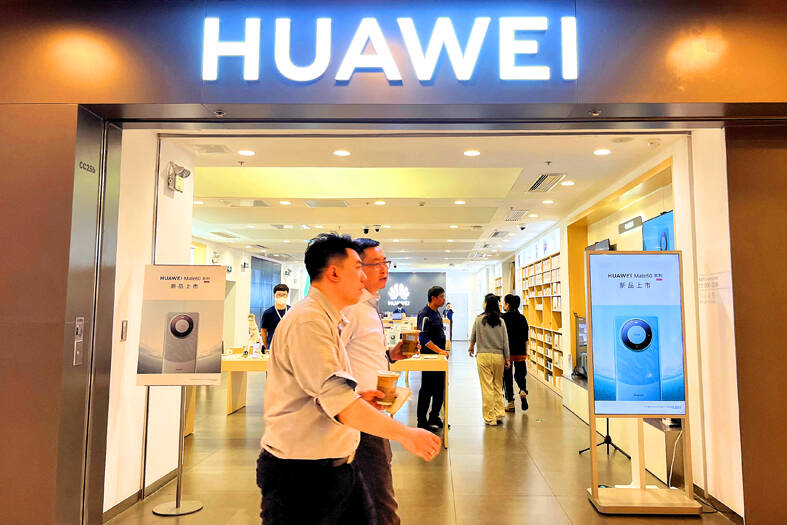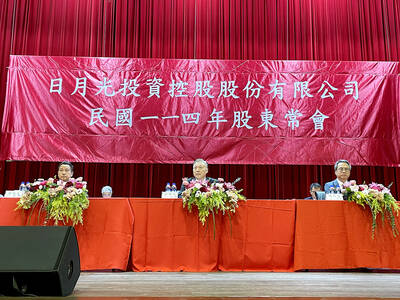The surprise launch of a sophisticated US$900-plus Huawei Technologies Co (華為) smartphone has captivated China’s technology industry, inspiring hopes that the country’s biggest firms can overcome US sanctions seemingly designed to thwart their ascendancy.
The slim-bezeled Mate 60 Pro, which appeared this week for sale online with little fanfare, ignited buzz among Chinese Internet commenters, who saw in the gadget Huawei’s resurgence after years of fighting US curbs on software and circuitry.
Many posted screenshots and videos of the gadget’s fast wireless performance, triggering speculation Huawei had managed to achieve 5G capabilities.

Photo: Reuters
Investors bought in.
Yesterday, shares in more than a dozen Chinese chip designers, gearmakers and Huawei suppliers surged between 8 and 20 percent.
The rally grew out of hopes that Huawei had somehow managed to design, manufacture and deploy a 5G chip capable of matching some of the best the US has to offer, despite a lack of access to advanced chipmaking at players including Taiwan Semiconductor Manufacturing Co (TSMC, 台積電).
Bloomberg News was unable to verify the authenticity of those reports.
The Chinese telecom regulator’s Web site did not show registration details for the model, as required of all wireless smartphones sold in the country.
The torrent of online reports only gained momentum, in part because of Huawei’s unique status as Chinese national champion and US bugbear. It yesterday topped the list of trending topics on social media Web site Sina Weibo. The idea appeared to endorse the “whole nation” narrative Beijing has espoused, where a nationwide effort can produce breakthroughs to counter the US.
The Mate 60 Pro is powered by a Kirin processor designed by Huawei’s chip arm HiSilicon Technologies Co (海思半導體), according to multiple teardown videos circulating online.
Several Web sites reported that the chip employed 5-nanometer node technology — just a generation behind the latest. Bloomberg News could not determine the manufacturer or sophistication of the chip.
Chinese chipmakers are not known to have mastered technologies as advanced as 5 nanometers. Huawei stockpiled such chips from TSMC right before US sanctions hit, but it is unclear whether the Mate 60 Pro might have used remnants of the company’s inventory.
“This new phone has huge significance. Though it is evident that Huawei was able to build this model only by sourcing and production in a roundabout way, regardless of what it went through to achieve this, Huawei did it,” said Shi Junbo (石軍波), a fund manager at Hangzhou XiYan Asset Management Co (杭州希言資產管理).
“But in terms of the sentiment lift for the industry today, that shares have been at their lows probably is the more important factor than the phone. One model is probably not going to be enough to have a lasting impact on the sector,” Shi added.
The rally was unusual not just for a lack of evidence to support the online enthusiasm, but also because it coincides with warning signs of Chinese financial and economic stress — in part because of US pressure.
Huawei is one of several Chinese companies at the center of Washington-Beijing tensions, the target of sanctions over allegations that it aids China’s military. The company, once the world’s biggest telecommunications provider, has been pulling out the stops since the US Department of Commerce added Huawei to its Entities List in 2019.
Huawei began by assigning thousands of engineers to try and replicate American technology, for instance in wireless chips. And it also began putting in place the infrastructure to ensure its future survival.
The leading association of global chip companies warned this year that Huawei is building a collection of semiconductor-fabrication facilities across China, a shadow manufacturing network that would let the blacklisted company turn its chip designs into reality.
It remains unclear how Huawei could have found workarounds to some of the most sweeping restrictions on China that the US has ever imposed.
Now, investors hope that Huawei can inspire its peers, several of which also labor under sanctions of varying severity. The Mate 60’s launch will be a catalyst for more homegrown, high-end smartphones, and trigger demand in the supply chain especially amid a downturn in semiconductors, Huajin Securities Co (華金證券) said in a note.
“It paves the way for Huawei to recover its shipments even quicker in its home country, with an almost zero-cost launch event,” Canalys senior vice president Nicole Peng (彭路平) said. “If the rumors are true, it means Huawei’s R&D [research and development] capabilities have largely exceeded the industry development timeline, which means it creates huge disruption to the semi industry and its competitors.”

Greek tourism student Katerina quit within a month of starting work at a five-star hotel in Halkidiki, one of the country’s top destinations, because she said conditions were so dire. Beyond the bad pay, the 22-year-old said that her working and living conditions were “miserable and unacceptable.” Millions holiday in Greece every year, but its vital tourism industry is finding it harder and harder to recruit Greeks to look after them. “I was asked to work in any department of the hotel where there was a need, from service to cleaning,” said Katerina, a tourism and marketing student, who would

i Gasoline and diesel prices at fuel stations are this week to rise NT$0.1 per liter, as tensions in the Middle East pushed crude oil prices higher last week, CPC Corp, Taiwan (台灣中油) and Formosa Petrochemical Corp (台塑石化) said yesterday. International crude oil prices last week rose for the third consecutive week due to an escalating conflict between Israel and Iran, as the market is concerned that the situation in the Middle East might affect crude oil supply, CPC and Formosa said in separate statements. Front-month Brent crude oil futures — the international oil benchmark — rose 3.75 percent to settle at US$77.01

Merida Industry Co (美利達) has seen signs of recovery in the US and European markets this year, as customers are gradually depleting their inventories, the bicycle maker told shareholders yesterday. Given robust growth in new orders at its Taiwanese factory, coupled with its subsidiaries’ improving performance, Merida said it remains confident about the bicycle market’s prospects and expects steady growth in its core business this year. CAUTION ON CHINA However, the company must handle the Chinese market with great caution, as sales of road bikes there have declined significantly, affecting its revenue and profitability, Merida said in a statement, adding that it would

UNCERTAINTIES: The world’s biggest chip packager and tester is closely monitoring the US’ tariff policy before making any capacity adjustments, a company official said ASE Technology Holding Inc (日月光投控), the world’s biggest chip packager and tester, yesterday said it is cautiously evaluating new advanced packaging capacity expansion in the US in response to customers’ requests amid uncertainties about the US’ tariff policy. Compared with its semiconductor peers, ASE has been relatively prudent about building new capacity in the US. However, the company is adjusting its global manufacturing footprint expansion after US President Donald Trump announced “reciprocal” tariffs in April, and new import duties targeting semiconductors and other items that are vital to national security. ASE subsidiary Siliconware Precision Industries Co (SPIL, 矽品精密) is participating in Nvidia